Hello Indonesian Culture friends. Have you ever heard of an endangered Indonesian endemic animal called the Komodo Dragons?

According to a study published in the journal PLOS One in 2009, Komodo dragons in Australia underwent extinction approximately 50,000 years ago.
The Komodo dragon, an animal native to Indonesia's Eastern Archipelago, is currently facing extinction despite being classified as an endemic species. Its habitat is limited to this region alone, with origins believed to trace back to Australia or the "green continent." According to Arnaz Mehta Erdmann's Guide to the Ecological History of Komodo National Park, one theory suggests that the Komodo dragon migrated from Australia 900,000 years ago and eventually settled on Flores Island after passing through several Indonesian islands.
It is believed that the migration of Komodo dragons took place during a period when sea levels were 85 meters lower than current conditions, allowing them to migrate and spread to other islands from Flores.
Habitat Komodo Dragon
At present, the habitat of the Komodo dragon is restricted to Indonesia, specifically on Komodo Island, Rinca Island, Gili Motang Island, and a small section in the northern and western regions of Flores. The Komodo National Park is also in place, managed directly by the Task Force Unit of the Ministry of Environment and Forestry of the Republic of Indonesia.
Komodo National Park, established in 1980, is one of the first five national parks in Indonesia and is recognized as one of the 21 Model National Parks in the country. Located in the Komodo District, Manggarai Regency, East Nusa Tenggara Province, it serves as the exclusive habitat of the ancient and endangered species of Komodo dragon (Varanus komodoensis). These giant lizards, with a length of 2-3 meters and a weight of up to 165 kg (or 100 kg on an empty stomach), are unique creatures that can only be found within the boundaries of the Komodo National Park.
The exceptional and scarce nature of the Komodo National Park led to its recognition as a World Heritage Site and a Man and Biosphere Reserve by UNESCO in 1986. Scientific research on the park began in 1911 by JKH Van Steyn, and the conservation objectives have since expanded to cover all forms of biodiversity, including those of the land and sea.
Komodo National Park encompasses a land area of 603 km², consisting of three primary islands, namely Komodo, Rinca, and Padar Islands, along with numerous smaller ones. Its present-day overall area measures 1,817 km², but an expansion to include an additional 25 km² (Banta Island) and 479 km² of surrounding waters would bring the total area up to 2,321 km².
Within the boundaries of Komodo National Park, visitors can observe a wide range of animals, including horses, wild bulls, deer, male wild boars, snakes, monkeys, and several species of birds. Additionally, the park boasts an extraordinary underwater ecosystem, with divers hailing the Komodo waters as one of the world's top diving destinations.
There are five popular tourist destinations that visitors can explore in the park, including Loh Buaya, Pink Beach, Gili Laba, Kelor Island, and Komodo Tourism Village. These locations showcase the islands' stunning beauty and provide visitors with unforgettable experiences.
Why do Komodo Dragons Migrate from Australia to Indonesia?
Maybe there are Indonesian Culture friends who ask like that.
Okay, so the limited distribution of the Komodo dragon's habitat can be attributed to the behavior of this colossal lizard. According to National Geographic, Komodo dragons have a strong aversion to leaving the place where they were born and raised.
National Geographic has stated that Komodo dragons have adapted to and survived the extreme weather conditions in their habitat on the Lesser Sunda Islands in Indonesia for millions of years.
However, research published in Proceedings B of the Royal Society conducted a decade-long study on the behavior and movement patterns of the Komodo dragon, which contradicts this notion. The study found that Komodo dragons are active animals and can walk up to 7 miles per day.
"They are really active by lizard standards," said Tim Jessop, one of the lead authors of the study, as quoted by National Geographic.
Jessop and his team also discovered that the "homebody" behavior of Komodo dragons is an intentional instinct, rather than a result of laziness or blindness. If relocated to the opposite end of the island, the dragon will return home safely several months later, as if the reptile already knows the way.

Post a Comment for "Komodo Dragons: Endemic Animal in Indonesia"